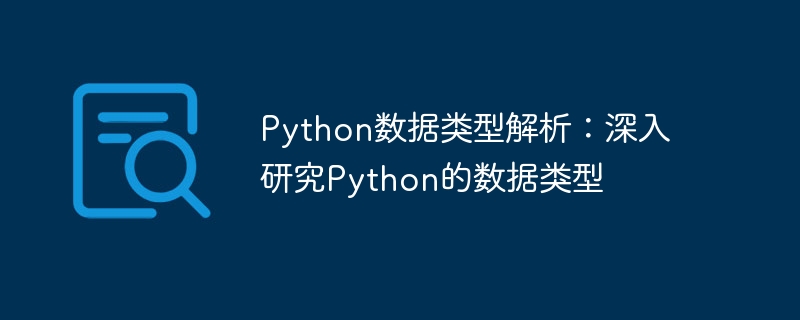

Python data type analysis: In-depth study of Python data types requires specific code examples
Introduction:
In Python programming, data types are very important concept. Understanding different data types and their characteristics can help us better process and manipulate data. This article will take an in-depth look at Python's various data types and provide specific code examples.
1. Number type (Number)
In Python, the number type is a very basic and commonly used data type. Among the digital types, they mainly include integers (int), floating point numbers (float), complex numbers (complex), etc. You can use the type() function to check the data type of a variable.
Sample code:
num1 = 10 # 定义一个整数变量 print(type(num1)) # 输出变量的数据类型 num2 = 3.14 # 定义一个浮点数变量 print(type(num2)) # 输出变量的数据类型 num3 = 2 + 3j # 定义一个复数变量 print(type(num3)) # 输出变量的数据类型
Running result:
<class 'int'> <class 'float'> <class 'complex'>
2. String type (String)
The string type represents text data in Python. You can use single quotes or double quotes to define strings, and you can perform a series of string operations, such as splicing, slicing, etc.
Sample code:
str1 = 'Hello ' # 定义一个字符串变量 str2 = "Python" # 定义一个字符串变量 str3 = str1 + str2 # 字符串拼接 print(str3) # 输出拼接后的字符串 print(str2[0]) # 输出字符串的第一个字符 print(str2[1:4]) # 输出字符串的切片 print(len(str2)) # 输出字符串的长度
Running result:
Hello Python P yth 6
3. List type (List)
The list type is one of the most commonly used data types in Python one. Lists are ordered, mutable sequences that can contain elements of different types. Square brackets can be used to define a list, and a series of list operations can be performed, such as insertion, deletion, slicing, etc.
Sample code:
list1 = [1, 2, 3, 4, 5] # 定义一个列表变量 print(list1) # 输出整个列表 list2 = ['a', 'b', 'c'] # 定义一个列表变量 print(list2) # 输出整个列表 list1.append(6) # 列表添加元素 print(list1) # 输出添加元素后的列表 list1.remove(3) # 列表删除元素 print(list1) # 输出删除元素后的列表 print(list2[0]) # 输出列表的第一个元素 print(list2[1:3]) # 输出列表的切片 print(len(list1)) # 输出列表的长度
Running result:
[1, 2, 3, 4, 5] ['a', 'b', 'c'] [1, 2, 3, 4, 5, 6] [1, 2, 4, 5, 6] a ['b', 'c'] 5
4. Tuple type (Tuple)
The tuple type is also a commonly used data type in Python one. Tuples are very similar to lists, but tuples are immutable sequences. A tuple can be defined using parentheses or without any parentheses.
Sample code:
tuple1 = (1, 2, 3, 4, 5) # 定义一个元组变量 print(tuple1) # 输出整个元组 tuple2 = 'a', 'b', 'c' # 定义一个元组变量 print(tuple2) # 输出整个元组 print(tuple1[0]) # 输出元组的第一个元素 print(tuple1[1:4]) # 输出元组的切片 print(len(tuple1)) # 输出元组的长度
Running results:
(1, 2, 3, 4, 5)
('a', 'b', 'c')
1
(2, 3, 4)
55. Dictionary type (Dictionary)
The dictionary type is a very important and commonly used data in Python type. Dictionaries are used to store key-value pairs, similar to dictionaries in real life. You can use curly braces to define a dictionary, and you can perform a series of dictionary operations, such as getting values, modifying values, adding key-value pairs, etc.
Sample code:
dict1 = {'name': 'Tom', 'age': 18, 'gender': 'male'} # 定义一个字典变量
print(dict1) # 输出整个字典
print(dict1['name']) # 输出键为'name'的值
print(dict1.get('age')) # 输出键为'age'的值
dict1['age'] = 20 # 修改键为'age'的值
print(dict1) # 输出修改后的字典
dict1['address'] = 'Beijing' # 添加新的键值对
print(dict1) # 输出添加后的字典
print(len(dict1)) # 输出字典的长度Running results:
{'name': 'Tom', 'age': 18, 'gender': 'male'}
Tom
18
{'name': 'Tom', 'age': 20, 'gender': 'male'}
{'name': 'Tom', 'age': 20, 'gender': 'male', 'address': 'Beijing'}
4Conclusion:
This article provides an in-depth study of Python's various data types and provides specific code examples. By learning the characteristics and operations of these data types, I believe readers can process and operate data more flexibly and efficiently, and improve programming capabilities and development efficiency.
The above is the detailed content of Exploring Python data types: An in-depth analysis of the characteristics of Python data types. For more information, please follow other related articles on the PHP Chinese website!




